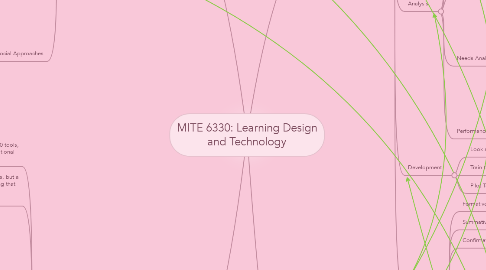
1. ADDIE
1.1. Design
1.1.1. Design Plan
1.1.1.1. Deliverables
1.1.1.2. Facilitator prerequisites
1.1.1.3. Participant prerequisites
1.1.1.4. Evaluation strategy
1.1.1.5. Description
1.1.1.6. Objectives
1.1.1.7. Target audience
1.1.1.8. Rationale
1.1.2. Objectives
1.1.2.1. Objective Domains
1.1.2.1.1. Cognitive
1.1.2.1.2. Affective
1.1.2.1.3. Psychomotor
1.1.2.2. A-B-C-D
1.1.2.2.1. Audience
1.1.2.2.2. Behavior
1.1.2.2.3. Condition
1.1.2.2.4. Degree
1.1.3. Lesson Plan
1.1.3.1. Nine Events of Instruction
1.1.3.1.1. Gaining attention
1.1.3.1.2. Information leaner of lesson objective
1.1.3.1.3. Stimulating recall of prior learning
1.1.3.1.4. Present the content
1.1.3.1.5. Guiding learning
1.1.3.1.6. Eliciting performance
1.1.3.1.7. Providing feedback
1.1.3.1.8. Assessing performance
1.1.3.1.9. Enhancing retention and learning transfer
1.2. Implementation
1.2.1. Align with Kirkpatrick's 4 levels of Evaluation
1.3. Analysis
1.3.1. Task Analysis
1.3.1.1. Procedural Analysis
1.3.1.2. Topic Analysis
1.3.1.3. critical incident analysis
1.3.2. Contextual Analysis
1.3.2.1. Orienting context
1.3.2.2. Delivery/instructional context
1.3.2.3. Transfer context
1.3.3. Learner Analysis
1.3.4. Needs Analysis
1.3.4.1. Needs Assessment Report
1.3.4.1.1. Research question/statement
1.3.4.1.2. Target audience
1.3.4.1.3. How data will be collected
1.3.4.1.4. Protocol
1.3.4.1.5. How data will be analyzed
1.3.4.1.6. Who data will be reported to
1.3.4.1.7. How data will be used
1.3.5. Performance Problem
1.3.5.1. Gap
1.4. Development
1.4.1. Look and Feel
1.4.2. Train the Trainer Courses
1.4.3. Pilot Testing
1.5. Evaluation
1.5.1. Formative
1.5.2. Summative
1.5.3. Confirmative
1.5.4. Kirkpatrick's 4 levels
1.5.4.1. Reaction
1.5.4.1.1. To what degree participants react favorably to the learning event
1.5.4.2. Learning
1.5.4.2.1. To what degree participants acquire the intended knowledge,skills,and attitudes based on their participation in the learning event.
1.5.4.3. Behavior
1.5.4.3.1. To what degree participants apply what they learned during training when they are back on their study.
1.5.4.4. Results
1.5.4.4.1. To what degree targeted outcomes occur,as a result of the learning event(s) and subsequent reinforcement.
2. Learning Theoties
2.1. Behavourist
2.1.1. Watson
2.1.1.1. 1.Unconditioned stimulus---->Unconditioned response
2.1.1.2. 2.Unconditioned stimulus with conditioned stimulus----->Unconditioned response
2.1.1.3. 3.Conditioned stimulus---->Conditioned response
2.1.2. Skinner
2.1.2.1. Programmed Instruction
2.1.2.1.1. 1.Knowledge comes in units arranged linearly.
2.1.2.1.2. 2.Machines deliver these units.
2.1.2.1.3. 3.Students move through material at their own pace.
2.2. Cognitive
2.2.1. Social Cognitive Theory
2.2.1.1. Bandura
2.2.1.2. Personal Factors
2.2.1.3. Behaviour
2.2.1.4. Environment
2.2.2. Cognitive Information Processing
2.2.2.1. Short-term memory
2.2.2.1.1. Discarded---->forgotten
2.2.2.2. Long-term memory
2.2.2.2.1. Discarded---->forgotten
2.2.3. Meaningful Learning Theory
2.2.3.1. Ausubel
2.2.3.1.1. Meaningful Knowledge
2.3. Constructivist
2.3.1. Piaget
2.3.1.1. role of the leaner:in environment which influences learning
2.3.2. Vygotsky
2.3.2.1. role of the leaner:interwoven learning
2.3.3. Bruner
2.3.3.1. role of the leaner:a part of community which influences learning
2.4. Social Approaches
2.4.1. Distributed Cognition
2.4.1.1. Hutchins
2.4.1.2. "Knowledge and cognition is distributed across objects,individuals,artifacts,and tools in the environment"
2.4.2. Situated Cognition
2.4.2.1. Gibson,Brown,Collins,&Duguid
2.4.2.2. "Knowledge is situated,being in part a product of the activity,context,and culture in which it is developed and used"
2.4.3. Activity Theory
2.4.3.1. Vygotsky,Lenten,&Luria
2.4.3.2. "...emphasizes the centrality of practice as doing and activity,but also foregrounds setting and context as essential orienting concepts"
3. Web 2.0 Based Learning technology
3.1. ICTs, and in particular the new Web 2.0 tools, present a major challenge to all educational and training organizations.
3.2. Web 2.0 represents not just a new generation of tools, but a significant shift in approaches to teaching and learning that challenge the very existence of formal educational institutions.
3.3. the tools of Web 2.0
3.3.1. Blogs
3.3.1.1. Allows an individual to make regular postings to the Web,e.g.,a personal diary or an analysis of current events
3.3.1.1.1. WordPress
3.3.1.1.2. Strikingly
3.3.1.1.3. weebly
3.3.2. Wikis
3.3.2.1. An “open” collective publication, allowing people to contribute or create a body of information
3.3.2.1.1. Wikipedia
3.3.3. Social networking
3.3.3.1. A social utility that connects people with friends and others who work, study, and live around them
3.3.3.1.1. Facebook
3.3.4. Multimedia archives
3.3.4.1. Allows end-users to access, store, download, and share audio recordings, photographs, and videos
3.3.4.1.1. Podcasts
3.3.4.1.2. YouTube
3.3.4.1.3. Flicker
3.3.4.1.4. E-portfolios
3.3.5. Synchronous communica- tion tools
3.3.5.1. Allows free “real-time” audio and visual commu- nication over the Web
3.3.5.1.1. Skype
3.3.5.1.2. Elluminate
3.3.5.1.3. Adobe Connect
3.3.6. 3-D virtual worlds
3.3.6.1. Real-time semi-random connection/ communication with virtual sites and people
3.3.6.1.1. Second Life
3.3.7. Multiplayer games
3.3.7.1. Enables players to compete against or collaborate with each other or a third party/parties represented by the computer, usually in real time
3.3.7.1.1. Lord of the Rings Online
3.3.8. Mobile learning
3.3.8.1. Enables users to access multiple information formats (voice, text, video, etc.) at any time, any place
3.3.8.1.1. Mobile phones
3.3.9. Open content
3.3.9.1. Digital learning materials available free over the Internet, for use either by instructors or learners
3.3.9.1.1. MIT OpenCourseWare
3.4. Education with web 2.0 tools
3.4.1. Social and Collaborative Networking
3.4.1.1. The Web
3.4.2. Multimedia Archives
3.4.3. Synchronous Technologies
3.4.4. Virtual WorldVirtual Worlds
3.4.5. Digital Games
3.4.6. Mobile Learning
4. Instructional Theories
4.1. Methodology(is driven by)
4.1.1. ADDIE
4.1.2. ISD
4.2. Professional Development
4.2.1. Mentorship
4.2.2. Training
4.2.3. Self study
4.2.4. Experience
4.3. Learning Theory
4.3.1. Constructivist
4.3.2. Cognitivist
4.3.3. Behaviorist
4.4. Educational Content(be created)
4.4.1. is deployed as
4.4.1.1. traditional courses
4.4.1.2. textbooks
4.4.1.3. websites
4.4.1.4. courseware
4.4.1.5. project based learning
4.4.2. Technical Resources
4.4.2.1. Hardwares
4.4.2.1.1. video camera
4.4.2.1.2. sound recording
4.4.2.1.3. digital camera
4.4.2.1.4. computers
4.4.2.2. Software
4.4.2.2.1. design and programming
4.4.2.2.2. hosting
4.4.2.2.3. editing
4.4.2.2.4. project management
4.4.2.2.5. collaboration
